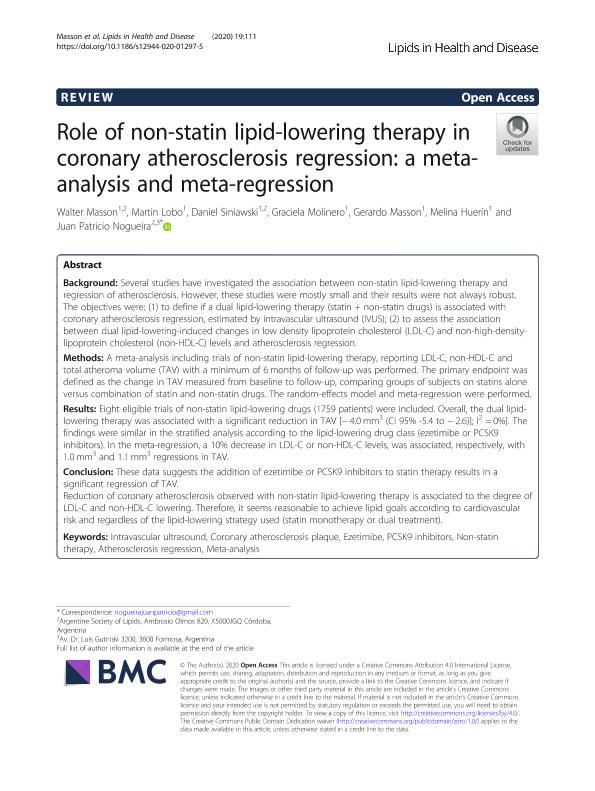Artículo
Role of non-statin lipid-lowering therapy in coronary atherosclerosis regression: A meta-analysis and meta-regression
Masson, Walter; Lobo, Martin; Siniawski, Daniel; Molinero, Graciela; Masson, Gerardo; Huerín, Melina; Nogueira, Juan Patricio

Fecha de publicación:
05/2020
Editorial:
BioMed Central
Revista:
Lipids In Health And Disease
ISSN:
1476-511X
Idioma:
Inglés
Tipo de recurso:
Artículo publicado
Clasificación temática:
Resumen
Background: Several studies have investigated the association between non-statin lipid-lowering therapy and regression of atherosclerosis. However, these studies were mostly small and their results were not always robust. The objectives were: (1) to define if a dual lipid-lowering therapy (statin + non-statin drugs) is associated with coronary atherosclerosis regression, estimated by intravascular ultrasound (IVUS); (2) to assess the association between dual lipid-lowering-induced changes in low density lipoprotein cholesterol (LDL-C) and non-high-density-lipoprotein cholesterol (non-HDL-C) levels and atherosclerosis regression. Methods: A meta-analysis including trials of non-statin lipid-lowering therapy, reporting LDL-C, non-HDL-C and total atheroma volume (TAV) with a minimum of 6 months of follow-up was performed. The primary endpoint was defined as the change in TAV measured from baseline to follow-up, comparing groups of subjects on statins alone versus combination of statin and non-statin drugs. The random-effects model and meta-regression were performed. Results: Eight eligible trials of non-statin lipid-lowering drugs (1759 patients) were included. Overall, the dual lipid-lowering therapy was associated with a significant reduction in TAV [- 4.0 mm3 (CI 95% -5.4 to - 2.6)]; I2 = 0%]. The findings were similar in the stratified analysis according to the lipid-lowering drug class (ezetimibe or PCSK9 inhibitors). In the meta-regression, a 10% decrease in LDL-C or non-HDL-C levels, was associated, respectively, with 1.0 mm3 and 1.1 mm3 regressions in TAV. Conclusion: These data suggests the addition of ezetimibe or PCSK9 inhibitors to statin therapy results in a significant regression of TAV. Reduction of coronary atherosclerosis observed with non-statin lipid-lowering therapy is associated to the degree of LDL-C and non-HDL-C lowering. Therefore, it seems reasonable to achieve lipid goals according to cardiovascular risk and regardless of the lipid-lowering strategy used (statin monotherapy or dual treatment).
Archivos asociados
Licencia
Identificadores
Colecciones
Articulos(CCT - NORDESTE)
Articulos de CTRO.CIENTIFICO TECNOL.CONICET - NORDESTE
Articulos de CTRO.CIENTIFICO TECNOL.CONICET - NORDESTE
Citación
Masson, Walter; Lobo, Martin; Siniawski, Daniel; Molinero, Graciela; Masson, Gerardo; et al.; Role of non-statin lipid-lowering therapy in coronary atherosclerosis regression: A meta-analysis and meta-regression; BioMed Central; Lipids In Health And Disease; 19; 1; 5-2020; 1-11
Compartir
Altmétricas



